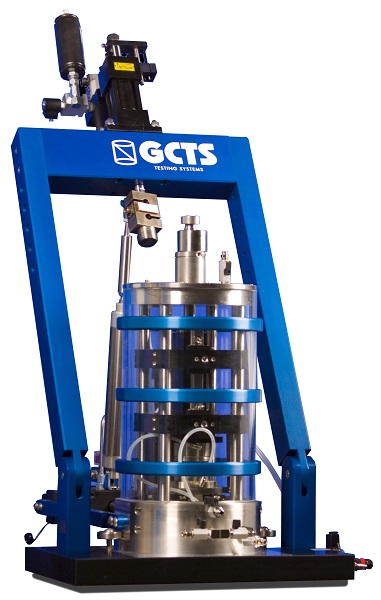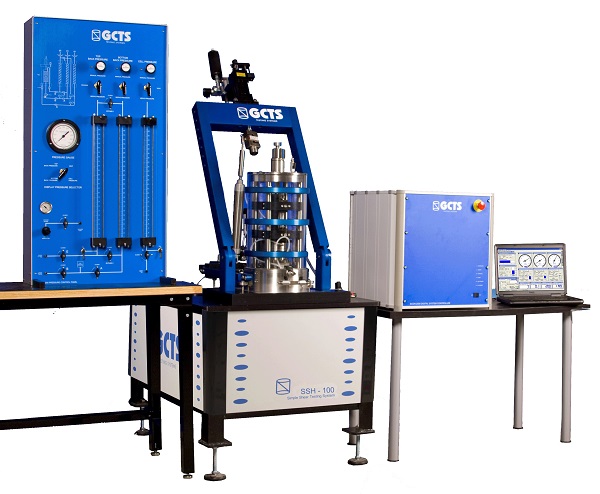Other Shear Tests:
Other Relevant Sites:
Simple Shear Test
Overview
The Simple Shear Test is a laboratory test commonly performed on cohesive and granular soils in order to determine various soil characteristics. During the test, the volume of the specimen is held constant, so the specimen is sheared under the undrained condition, which means that no water is allowed to exit the specimen during shearing. A specimen is held between two end caps and the shearing force is caused by the horizontal movement of the bottom cap. This test is comparable to the Direct Shear Test or the Triaxial Test, as these can all be used to quickly calculate the shear strength of a soil.

Simple Shear Testing Equipment (Courtesy of GCTS)
How is a Simple Shear Test Performed?
When performing a simple shear test, a cylindrical specimen is placed inside a stack of thin, hollow plates that will confine the specimen in the horizontal direction. Two porous disks are placed on top and below the confined specimen and the specimen is placed on the bottom platen. The top platen is brought into contact with the top of the specimen and the entire apparatus is submerged in water. The specimen is allowed to fill with water while the initial height is unchanged, allowing it to become fully saturated. The specimen is then consolidated, which means that the normal load on top of the specimen will be slowly increased to the consolidation pressure to allow water to seep out.
Once the specimen has fully consolidated and is no longer decreasing in height, the shearing stage of the test can be performed. The axial load is allowed to change during the test in order to prevent the height of the specimen from changing. A force is applied to the bottom platen, pushing it from under the specimen. Since the specimen is causing a normal force on the bottom platen, the movement of this platen causes a frictional force on the bottom of the specimen, which is the resulting shearing force. This platen is moved at a constant, but slow, rate of strain (generally around 5% per hour) until 20% shear strain has been reached or until the shear force has dropped to 80% of the maximum value. The shear strain, shear force, axial strain, axial force, and time should all be recorded during the test.
What Does a Simple Shear Test Specimen Look Like?
A typical specimen is cylindrical in shape with a diameter of at least 45 mm (1.77 in.) and a height of at least 12 mm (0.47 in.). A specimen can come either directly from its in situ condition or be constructed in the lab. The initial water content, mass, height, and area of the specimen should all be measured and recorded before testing.
How are Soil Characteristics Determined?
After performing the test on (at minimum) three different specimens, the sample characteristics can be determined. First, a graph should be created with the maximum shear stress on the y axis and the corresponding normal stress on the x axis. Linear regression can be used to create a line of best fit for the data, which is the Mohr-Coulomb Failure Envelope. The resulting slope of this line is the calculated angle of internal friction for the sample and the resulting y intercept of this line is the calculated cohesion for the sample.
Another graph can be created with the shear strain on the y axis and the shear stress on the x axis. This allows for an analysis of the stress-strain characteristics of the soil, as the initial constant slope of this graph is the calculated shear modulus of the sample.
What are the Trade Offs for the Simple Shear Test?
The simple shear test is a relatively quick and easy method for determining the characteristics of soils. It gives information about the angle of internal friction, cohesion, and stress-strain characteristics of a soil without the lengthy specimen preparation and intensive testing procedure of a soil triaxial test. However, the simple shear test is not as accurate as the soil triaxial test. In the simple shear test, the use of confining rings and the end platen used to apply the shear force causes an uneven distribution of stresses within the specimen, which can cause the failure plane to occur in a place of the highest stress rather than on the weakest plane. In addition, while the test is performed, the principal stresses are constantly rotating, so it is not possible to perform a full Mohr’s Circle Analysis. Although these limitations prevent perfectly accurate results, the simple shear test does provide reasonable approximations of soils characteristics in a relatively easy manner.
Keywords: Shear — Simple Shear — Stress — Cohesive Soils — Consolidation — Undrained — Constant Volume Test — Shear Apparatus — Shear Strain — Shear Strength — Simple Shear Test — Simple Shear Test Machine — Simple Shear Test System — Simple Shear Test Equipment — Simple Shear Tester
© 2016 Geotechnical Consulting and Testing Systems, LLC. All Rights Reserved.

